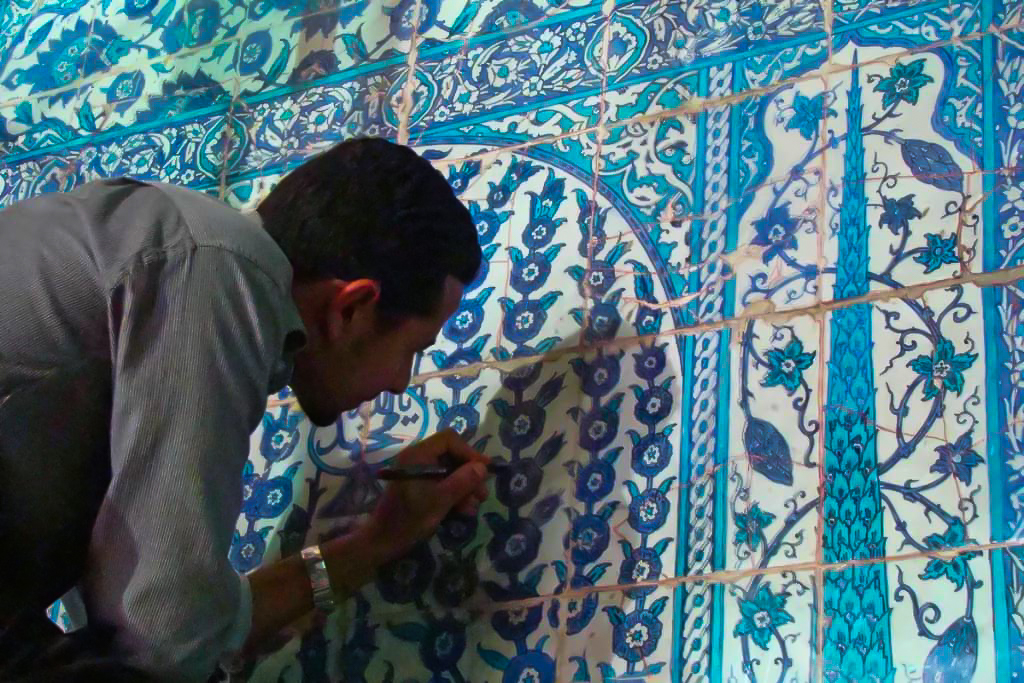The Mosque of Aqsunqur or the Blue Mosque is one of the prettiest and quietest places in Cairo. It lies nearby the Mosque-Mausoleum of Khayrbak and the Waqf of Ibrahim Agha Mustafizan in El Darbel Ahmar on the right side of Bab EL Wazir Street. This pretty monument got its name due to the abundance of blue tiles that decorate its interiors. These are types of Iznik and were added by Ibrahim Agha. The founder, however, was not him and the mosque of Aqsunqur was built by Emir Shams El-Din Aqsunqur, one of the most prominent noblemen in the Mamluk period. Keeping in pattern with many of the Mamluk noblemen’s fate, the Emir Shams El-Din Aqsunqur was condemned to death after his participation in a plot against Sultan El Kamil Shaban in 1347.

A gorgeous blue tile of the mosque of Aqsunqur
Table of Contents
The mosque of Aqsunqur
Some of the prettiest features of the mosque of Aqsunqur are its circular columns and simple, elegant interiors. The façade is inlaid with handsome blue-gray marble while the entrance is decorated with an arched recess with two finely carved brackets. Nowadays, many parts of that mosque are ruined, and the only remaining part is the wall of the Qibla. There is also a dome above the Mihrab and a fountain dating back to 1412/815. The Mihrab of the mosque is a fine example of early Mamluk religious architecture.

Interior of the mosque of Aqsunqur
The Ottoman restoration
The magnificent mosque of Aqsunqur houses a number of mausoleums some of which belong to Shams El-Din Aqsunqur, the mosque’s founder, his sons, and a number of children from a Mamluk sultan. There is also the mausoleum of Ibrahim Agha who first undertook the responsibility of extensive restoration work after the mosque fell into a state of disrepair. That was in 1652 during the Ottoman period. The renovation process that lasted from 1652 to 1654 saw the mosque’s roof and all the mosque’s arcades being completely restored, and a number of columns added to the interior. It is believed that the new patron Ibrahim Agha also ordered extensive redecoration of the mosque’s interiors. He added the charming blue and green tiles crafted in typical Iznik style, all of which were brought in from Constantinople and Damascus thus rendering the mosque its charming name of the “Blue Mosque”.

A tomb inside the complex
The following restoration projects
He also gave orders to have his own mausoleum built within the mosque complex. Due to his dedicated restoration work, the mosque of Aqsunqur was renamed after him. However, for some reason, its new name was hardly ever used and the mosque of Aqsunqur continued to be hailed after its original creator. The monument received a second facelift in 1902 after a powerful earthquake cracked some of the courtyard portico arches. That was the second major renovation and restoration project and another one sponsored by the Egyptian government followed in 1995. In 2009, the mosque of Aqsunqur was once again closed for renovations and restoration work, a project that continued until 2015, at which point the mosque finally opened its doors once again to the public.
Address – Bab El Wazir Street, Qism El-Khalifa, Cairo
Opening Times – 11:00 – 19:00 daily
There is no entrance fee. However, one may tip the caretaker of the mosque if one wishes.

Dome of the mosque of Aqsunqur

The caretaker walks past the blue-tiled wall of the mosque of Aqsunqur

Restoration work of the mosque of Aqsunqur
Photo Credit – https://www.wmf.org/

Restoration work of the dome of the mosque of Aqsunqur
Photo Credit – https://www.wmf.org/

Restoration work of the mosque of Aqsunqur
Photo Credit – https://www.wmf.org/

Mosque of Aqsunqur
P.S – This blog post is part of the weekly series called the Cairo Chronicles. Every week, Maverickbird will try to focus on a new theme, emotion, and beauty of expat life in the exciting, maddening city of Cairo.
Follow the rest of the Egypt series here
- SOUQ AL GOMA IN PHOTOS
- CAIRO FOOD TOUR
- SULTAN AL-MU’AYYAD MOSQUE
- STREET OF TENTMAKERS IN CAIRO
- COPTIC QUARTER OF CAIRO
- COPTIC MUSEUM IN CAIRO
- AL MANIAL, THE OFFBEAT GEM OF CAIRO
- THE GAYER ANDERSON MUSEUM IN CAIRO
- MAGNIFICENT QALAWUN COMPLEX
- AMAZING SAQQARA PYRAMIDS
- THE PYRAMIDS OF GIZA
- CAIRO’S HISTORIC MUIZZ STREET
- ISLAMIC CAIRO PHOTO WALKS
- KHAN EL KHALILI MARKET
- KHAN EL KHALILI GUIDE
- IS IBN TULUN MOSQUE THE MOST BEAUTIFUL ONE IN CAIRO?
- THE MAGNIFICENT SULTAN HASSAN MOSQUE MADRASSA
- MOSQUE-OF-AL-REFAIE IN CAIRO
- TANOURA DANCE OF EGYPT
- CAIRO STREET PHOTOGRAPHY
- AL GHURIYA MOSQUE-MAUSOLEUM
- MOSQUE OF ABU DAHAB
RESPONSIBLE TRAVELING-BECAUSE I CARE

